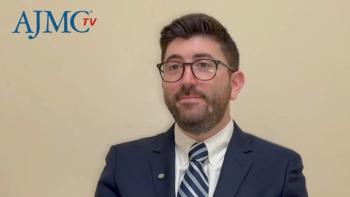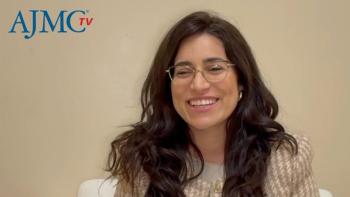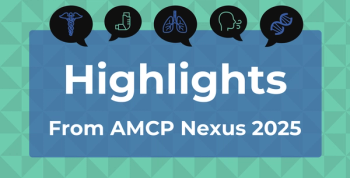
Defining the Comprehensive Role of the Oncology Pharmacist in Multiple Myeloma: Marcus Flores, PharmD, BCPS, BCOP
Marcus Flores, PharmD, BCPS, BCOP, discusses the vital role of pharmacists in multidisciplinary cancer care, exploring collaboration, patient-centered strategies, and AI.
Following the October 9 Institute for Value-Based Medicine® event, “Driving the Future of Cancer Care,” which saw experts gather in New York City from some of the top cancer care centers in the region—Memorial Sloan Kettering Cancer Center, Mount Sinai, NewYork-Presbyterian Brooklyn Methodist Hospital, Northwell Health, NYU Langone, and Yale School of Medicine—The American Journal of Managed Care® (AJMC®) spoke with Marcus Flores, PharmD, BCPS, BCOP. Flores was a panelist on the discussion titled “The Power of Team-Based Oncology.”
Flores, who works in the outpatient
This transcript was lightly edited for clarity.
AJMC: How can oncology care teams strengthen communication and coordination across disciplines to ensure patients experience seamless, integrated care?
FLORES: I think one of the ways, when feasible, is to have a structured rounding approach to patients, either on the inpatient or the outpatient side. Really having all of the different team members together reviewing the patient. The physician will evaluate the patient and come up with their diagnosis, and then, from my perspective, the pharmacist will be able to recommend changes to medication therapy or [warn about] important drug interactions to look out for. Social work can also perhaps chime in with information or resources to assist with important financial issues the patients are having or caregiver issues. Nurses also can chime in with what they've noticed; maybe they've seen the patient a little bit more often. Really, having that full picture is important so everyone can understand what's going on and then we're all on the same page.
AJMC: As cancer care becomes increasingly complex, what strategies can institutions use to balance innovation, efficiency, and patient-centered outcomes within multidisciplinary frameworks?
FLORES: One of the key things is really getting that input from the patients of what matters the most to them. Some organizations, particularly patient advocacy groups, will have a member who kind of sits in with some medical organization. The Multiple Myeloma Foundation has a patient advocate, where someone who's actually had myeloma can kind of speak to their experiences. I think having more prominent members like that who can speak out to what they've kind of gone through and what really matters to them would be important to kind of realign institutional goals and to make sure we're really meeting what's best for the patient and not always worried about the financial considerations or other things like that. Making sure we're really getting what's important to them, because at the end of the day, they're what's most important.
AJMC: You emphasized the pharmacist’s role in bridging communication between patients and clinicians. How can oncology practices better integrate pharmacists to enhance treatment adherence and manage adverse effects of treatment?
FLORES: What some institutions have done is develop a pharmacy referral program, especially in practices where pharmacists have advanced practice capabilities—where they're actually able to prescribe certain classes of medications. So, having the treating physician refer the patient to the pharmacist and then having the pharmacist do follow-up visits, where they can either see the patient in person or do virtual or telephone visits, to understand how the patient's [doing on a certain medication], any adverse effects they're having, and having the autonomy to then prescribe any supportive care that's needed. For example, if a patient's having some nausea that's not really responding to the first-line antiemetics that were prescribed, having that ability to then adjust the dose or add a second medication on board would be helpful, thus alleviating some of the time from the physician and allowing them to see more patients who might have more complex needs. This also allows the pharmacist to really practice at the top of their license and give the patient more immediate care, helping to meet their outcomes.
AJMC: Another important factor you mentioned was structural barriers, such as limited team availability in community settings. What practical steps can smaller oncology centers take to replicate the benefits of multidisciplinary collaboration?
FLORES: I think that can be challenging. One idea might be if there's a way to partner with maybe a remote pharmacy program, for example, at least from that perspective, so that way they can at least perform some remote counseling as well as medication adherence. I'm not really sure what might be a good strategy for some of the other disciplines to make sure they're well represented.
AJMC: You also describe data-driven approaches to demonstrate value and support administrative buy-in. How can collecting and presenting such data help sustain or expand care initiatives?
FLORES: Something that's common in at least the pharmacy world is we do small pilot studies where we'll have a pharmacist in a new area—for example, the emergency department—or on a unit in the hospital, and they'll collect data on patients they've seen or interventions they've made in terms of making dose adjustments or preventing certain interactions, and then quantify that in terms of dollar amounts. I think that's helpful to help demonstrate dollars saved by maybe preventing patients from coming back to the hospital or the potential cost of managing an adverse effect that could have happened if they weren't there to catch that. A lot of that tends to be a manual, laborious process right now, but having artificial intelligence [AI] to kind of easily comb through the data, pull out those numbers, and present them in a very meaningful way, I think would be helpful to present the data and free up the time from the pharmacist of having to do that themselves, and then allow them to collect more or perform more patient interactions or perform more medication reviews. Once we demonstrate that cost savings that's been generated, it helps build the case for getting more pharmacists on more units and different services. Maybe there's another service line that might need a pharmacist, and so this helps demonstrate the case of how much benefit they can provide to the hospital.
AJMC: Are there any concerns about the use of AI that you've heard from patients or clinicians?
FLORES: I think AI definitely has some pluses and minuses. I think it can make things easier for the health care professionals to free up some of their time. But I do see the potential risk of overreliance on AI. I think we've demonstrated through different articles out there that it's not always 100% reliable. An argument can be made that humans aren't 100% reliable either, but we also want to make sure that especially if professional students are coming in and they're used to relying on AI for a lot of information, that they're still using those critical thinking skills and not just relying 100% on AI. I don't know if I've heard concerns yet from patients, per se. I haven't really addressed that with them, but I think that's kind of my biggest concern: new pharmacy graduates are just thinking, “Oh, is there an interaction? Let me just ask ChatGPT or whoever it is for an answer.” Not thinking back to their pharmacy knowledge of: How does this medication work? Why would it interact with this? Instead, considering what are really the ramifications of that.
Newsletter
Stay ahead of policy, cost, and value—subscribe to AJMC for expert insights at the intersection of clinical care and health economics.













































